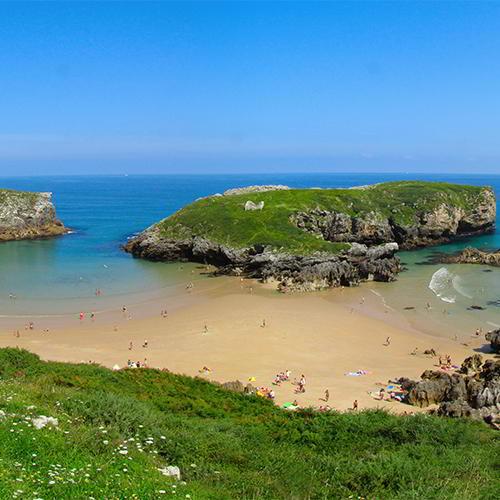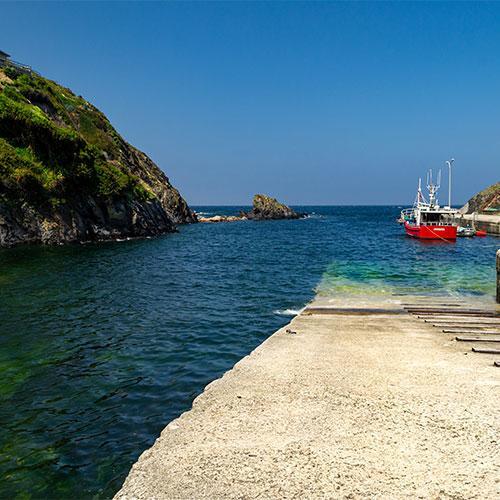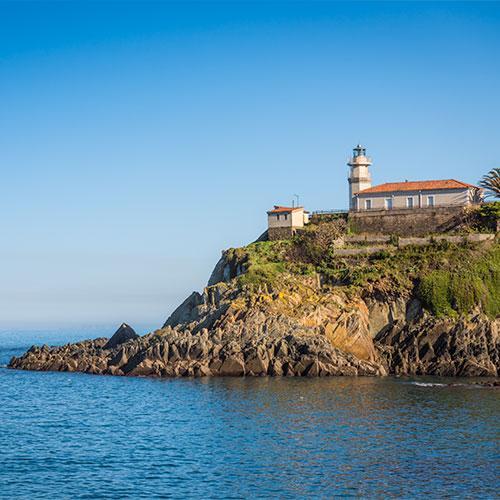The coast of Asturias, along its four hundred kilometers, showcases diverse and enriching landscapes and villages
We suggest
Discover Asturias' beautiful beaches, charming fishing villages and fascinating lighthouse route. Immerse yourself in unique seafaring experiences such as boat trips and fresh seafood tastings. A coastal paradise to explore and enjoy.
The unique topography of Asturias makes its coastline offer a landscape of contrasts between the sea and the mountains, reaching its fullness in the eastern coast, where the Picos de Europa dive into the Cantabrian Sea in a distance of just 20 kilometers
The coast of Asturias is a true natural, cultural, and human spectacle. Along its four hundred kilometers, you will find over 200 beaches, lighthouses, watchtowers, eighteen fishing villages and seaside towns, cliffs, rocky areas, viewpoints, chapels, capes, and paths - including the Northern Way or the Coastal Route. It's a whole world brought to life by fishermen, sailors, sports enthusiasts, nature lovers, hikers, travelers, excursionists, and all those individuals who, in one way or another, shape the landscape with their presence in this part of the Asturian nature.
/documents/39908/67659/candas-luanco.jpg/548d4fcc-ecdb-2eec-eb59-cc7e20b64e2d?t=1685693189658

Considered one of the best-preserved coastlines in Spain, the coast of Asturias is a world of natural and cultural wonders, such as blowholes - located in the eastern area of the region -, inland beaches, dinosaur footprints, Eo Estuary oysters, "pulpo del pedreru" (octopus caught among the rocks), "angula" (young eel) from the Nalón Estuary, coastal paths, beaches ideal for surfing and many other water sports, cemeteries by the estuary or sea, and lively villages that bring the coastline to life.
Furthermore, the coast of Asturias is known for its vibrant festivities. Many of the towns along the coast celebrate their festivals in honor of their patron saints, as well as gastronomic festivals paying tribute to the rich fish and seafood from the Cantabrian Sea and its marvelous estuaries. In fact, over twenty of these celebrations have been declared Festivals of Touristic Interest, either at a national level or by the Principality of Asturias, and they take place in well-known and emblematic coastal locations such as Gijón/Xixón, Llanes, Luarca/Ḷḷuarca, Salinas (Castrillón), Candás, Cudillero, Castropol, Lluanco/Luanco, Navia, Ribadesella/Ribeseya, or Pimiango (Ribadedeva).
/documents/39908/67659/bufones-pria.jpg/f30ce0fa-6774-4ed6-2c01-4fc3afd79951?t=1685693187425

Blowholes of Pría (Llames. Llanes)
Furthermore, another great attraction of this coast is the delicious and healthy seafood cuisine that you will find in its many bars, restaurants, cider houses, and seaside terraces
They will offer you all kinds of dishes and recipes, some more traditional and others more innovative, but all inspired by the excellence of a land that has the finest ingredients and great hospitality and catering professionals.
/documents/39908/67659/pulpo-pedreru.jpg/2b26dbea-b860-d410-a83d-7e7c9b60702a?t=1685693192547

"Pulpo de pedreru" (octopus caught among the rocks)
When it comes to fish and seafood, each season brings a new variety, and every month the species available in fish markets and restaurants change. Among the most abundant fish along this coast are mackerel, sardines - which have their own festival - and hake. It is also worth mentioning rock red mullet, turbot, John Dory, grouper, monkfish, red scorpionfish, conger eel, bream, sea bream, and anchovy.
As for seasonal products, in autumn you can enjoy baby eels (angulas), while summer offers sardines, squid caught with traditional handlines (chipirones de potera), and bonito, prepared in countless different ways - grilled, rolled, in chunks, or even as sashimi or tataki.
So, this coast has it all: breathtaking landscapes, towns and cities, culture, festivals, gastronomy, sports, and more. That's why the coast of Asturias is one of the best places to enjoy and connect with unspoiled nature and a vibrant social life
/documents/39908/67659/playa-de-la-franca.jpg/1e9fcef2-9d4b-f2a3-3aa5-c699ba395b06?t=1685693191078





